Sonic and Tension
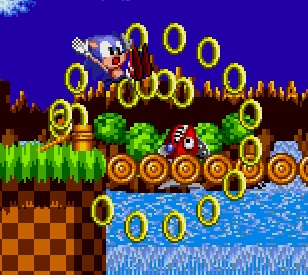 I am running and rolling then looping and blurring and the screen it is jittering as if it might. A mechanized wasp. A needled pit. A dull gray rock. But I return to a slope and I’m off no I’m on and I think of the term Sega used in the nineties to describe what it is I’m supposed to be feeling but.
I am running and rolling then looping and blurring and the screen it is jittering as if it might. A mechanized wasp. A needled pit. A dull gray rock. But I return to a slope and I’m off no I’m on and I think of the term Sega used in the nineties to describe what it is I’m supposed to be feeling but.
Sonic the Hedgehog irritates. Aggravates. I’ve quit playing Sonic, but I’m still chasing that feeling. Of stopping. Interruption. It carries forward, even when I’m caught up in the speed, the blast processing I suddenly remember being promised. This feeling of annoyance sticks, as little else does in Sonic.
Perhaps I used to relish feeling out of control. At least for those moments before I burst into rings of rings. Or maybe the wash of checkerboard hills and parallaxed water was enough reward for pressing right and (sometimes) a button.
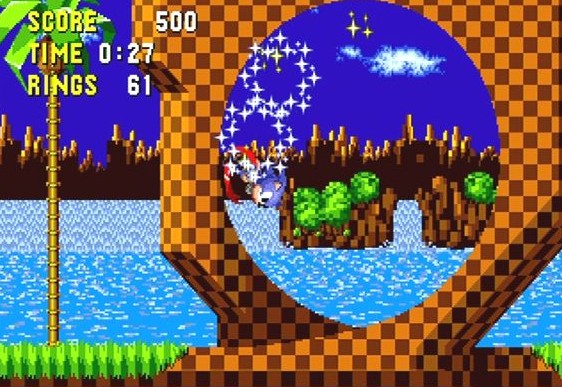 Now all I feel is tension. This is the lingering sensation of Sonic the Hedgehog. It follows from speed without involvement, from exhilaration unearned. Momentum’s one problem: either I can’t stop once I get going or I can’t get started at all. But I always feel pushed forward, some abstract urgency at my back. Besides, there’s no point in lingering.
Now all I feel is tension. This is the lingering sensation of Sonic the Hedgehog. It follows from speed without involvement, from exhilaration unearned. Momentum’s one problem: either I can’t stop once I get going or I can’t get started at all. But I always feel pushed forward, some abstract urgency at my back. Besides, there’s no point in lingering.
I want to zip through the levels as quickly as possible. Pretty as they are, there’s little pleasure in exploring their space, seeing it all. Or much fun to be had with Sonic’s imprecise platforming. I’m either tripping through stages (or rebounding or drowning), or I’m coasting along a path laid down for me by the distant gods of Sonic Team. Neither satisfies. I can’t prepare or predict; I can only memorize. And yet afterwards, I remember little of Sonic. It’s less than a blur.
Sonic’s levels aren’t built to be remembered. Their architecture is limited to a series of discrete situations, modular units, and too often not even that – just a collection of paths, rails, not a cohesive gamespace. A map of any one level resembles some sloppy mash of jagged elements whose slick patterns never convince me that I’m anywhere other than a stylish simulacrum, skimming a surface.
For a game supposedly built around speed, the first Sonic is remarkably slow. I can only recall sustained careening in its more spacious zones (Green Hill, Star Light). The underground block-pushing of Marble Zone, the maddening kickbacks of Spring Yard, the twirling conveyors of Scrap Brain, the water – WATER! – of Labyrinth Zone. Who was in charge of these levels? The game feels designed against itself, and all I’m left with is the resulting tension.
 Sonic has no pacing, no rhythm. Moments of balls-out speed punctuate interminable stretches of clumsy platforming. Interminable because you never know how long til the next break, the level modules being cobbled together without logic, sequence, flow. There is no buildup, no climbing the roller-coaster hill, no anticipation. Not much looking back either because most joyous spurts are cut short by some unfairly placed, unforeseeable foe.
Sonic has no pacing, no rhythm. Moments of balls-out speed punctuate interminable stretches of clumsy platforming. Interminable because you never know how long til the next break, the level modules being cobbled together without logic, sequence, flow. There is no buildup, no climbing the roller-coaster hill, no anticipation. Not much looking back either because most joyous spurts are cut short by some unfairly placed, unforeseeable foe.
Sonic must have half-inspired the many dead-serious speed runs that populate YouTube. But speed runs showcase seemingly superhuman (often computer-augmented) skills or a kind of game-breaking that comes through intense repetition and learning to maximize the through-lines of a structured space. They cut through the Gordian knot of game-design to reveal a simpler path, one present but invisible to our slow thumbs.
Sonic, however, must aspire to this gamestate AT ALL TIMES. It’s the only way to motivate play and promise a way through its sluggish platforming. The primary strategies are pathfinding, memorization, and a bit of timing. Sonic himself can only gain additional protection and speed to help with this. He has no other meaningful ways to interact with his world.
Still, Sonic the Hedgehog thinks it’s a platformer. And certainly it was marketed as such against the Super Mario series, which was, and remains, the heart of the genre. Twenty years running, it seems an unworthy comparison. But it does illuminate some of the tensions inherent to Sonic’s design.
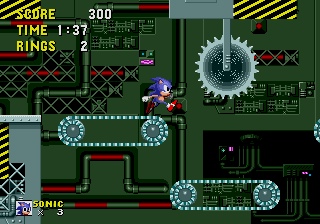 Sonic is sharp, a hedgehog as game. The landscape is pointed, the edges harsh. Mario curves, his belly, his jump. He is round, smooth, malleable, as is his world. Mario is even a ‘round’ character, in the high-school-English sense. He can absorb his environment (mushrooms, fireflowers, leaves) or swap clothes (capes, wetsuits, giant shoes). In other words, he changes; he’s human.
Sonic is sharp, a hedgehog as game. The landscape is pointed, the edges harsh. Mario curves, his belly, his jump. He is round, smooth, malleable, as is his world. Mario is even a ‘round’ character, in the high-school-English sense. He can absorb his environment (mushrooms, fireflowers, leaves) or swap clothes (capes, wetsuits, giant shoes). In other words, he changes; he’s human.
Sonic, though, is raw, elemental, pure – an animal. He can only extend his basic nature, becoming tougher (rings, a shield) or faster (ruby slippers). He’s flat, fixed, one-note, which would usually consign him to the role of sidekick. Actual protagonists who cannot change often meet a tragic fate (kissing/killing/eating some family member). Maybe Sonic would be more compelling if he gouged out those smirking eyes and ran blind. Actually, that’s exactly how I feel while playing.
 Invoking Greek tragedy around Sonic is silly not only for lack of a chorus. Sonic may have the requisite hubris, but he’s too cool for human longing and the icky emotional viscera of the slow. All he really wants is speed, but it’s not even full-on desire; it’s only the fulfillment of his nature. Besides, you can’t imagine Sonic accepting blame for any dawdling. The fault, his cocked eye claims, lies with the player.
Invoking Greek tragedy around Sonic is silly not only for lack of a chorus. Sonic may have the requisite hubris, but he’s too cool for human longing and the icky emotional viscera of the slow. All he really wants is speed, but it’s not even full-on desire; it’s only the fulfillment of his nature. Besides, you can’t imagine Sonic accepting blame for any dawdling. The fault, his cocked eye claims, lies with the player.
Sonic’s cool proceeds not only from his unflappable character; it’s also a function of his slick sci-fi world. Compare the defiled nature and urban congestion of the Sonicverse to the warmth of Super Mario’s elemental themes and wacky magic. One invites you in to play; one assaults your senses and dares you to take your time.
While Mario is an ordinary man in a fantastic world, Sonic is clearly of his own posthuman universe (whether an amnesiac mutant or just a precocious native). Both avatars are empty vessels, but only Mario has an interior that can be actively inhabited, filled up. Sonic is all surface and attitude, a style to be passively performed. It’s the difference between playing and being played.
In the end, though, it’s the control – the actual way Sonic and Mario play – that makes the biggest difference. Yes, cool doesn’t age and sharpness eventually grates, but it’s poor gameplay that annoys forever. Press a button, any button (there’s only one), and feel that tiny delay before Sonic jumps; those milliseconds are milliseconds that your hand-eye registers mercilessly. Feel the cutesy animations stutter on ledges, the sloppy skids and stiff mid-air retractions. Compare this to any Super Mario and feel the difference, the just-rightness that’s missing. Even the first Super Mario Bros, five years before the original Sonic, had the sense to include a second button for controlling running speed.
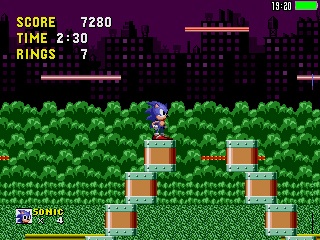 It’s almost as if Sonic Team knew that their gameplay was no match for their style. The entire ring collection mechanic seems designed around failure. You will get hit, and hit often, it assumes, so there’d better be some means of recovery scattered throughout each zone. Compared to the slimmer margins of Mario, where a hit means a precious loss of ability, and another certain death, the Sonic player, like a delinquent student, can quickly sense the lowered expectations.
It’s almost as if Sonic Team knew that their gameplay was no match for their style. The entire ring collection mechanic seems designed around failure. You will get hit, and hit often, it assumes, so there’d better be some means of recovery scattered throughout each zone. Compared to the slimmer margins of Mario, where a hit means a precious loss of ability, and another certain death, the Sonic player, like a delinquent student, can quickly sense the lowered expectations.
Mario gathers lives, second chances to the nth, and his 1ups have become emblematic of a videogame structure that makes death a natural part of life. Consider the pleasure that usually comes with earning a 1up – another chance to play, to try again in a world that, however difficult, feels just and fair (and your death your own responsibility). The rare extra life in Sonic, though, feels like a burden, a heavy gift necessary to face some bullshit lurking just beyond the right edge of the screen. It offers a dire forecast of stoppage, rupture, of a failed run.
The more plentiful rings offer little consolation. The penalty for becoming absorbed in the pleasures of a smooth run and then exploding into rings (weren’t you paying attention?) is too harsh. The loss of shiny baubles can still sting (see Kirby’s Epic Yarn) without killing the player’s motivation to collect. To keep 50 rings until the end of the level and access a round of bonus vertigo, the astute player will learn to slow down and poke through each level. And in a game about boldness and speed, what’s the point in skulking about?
Tension pervades Sonic. It’s a game at odds even with its own professed genre. It may look like a platformer; its weaker sections certainly ape the classics. But its distinctiveness emerges when it acts more like a racer or shooter. Its driving characteristics make intuitive sense, given the shared pleasures of speed. It’s here, though, that such a hybrid reveals its limits. Part of the thrill and satisfaction of racing comes with seeing what’s ahead and reacting in time. Sonic, as a platformer though, turns the course on its side and provides a severely restricted viewing window. Without being able to see further ahead in the course, the player is forced to race blind (or at least profoundly nearsighted).
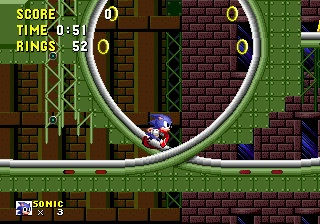 Its shooting pedigree may seem more obscure. But if we consider some of what a classic shooter requires (sharp reflexes, memorization) and how it rewards play (that surge of graphics and sound, the satisfaction of mastering speed and overwhelming odds), then it becomes clearer how Sonic fits in and how it fails. Obviously, Sonic can’t shoot, so his interactions with enemies and the environment are limited to avoidance and direct contact. But Sonic’s forward roll and simplistic jumping (the platformer verb) just don’t offer enough control in the gamespace to sustain the exhilaration a shooter promises (again the tardy Sonic button – imagine a shooter that paused before each bullet). Sure, Sonic can sometimes deliver a spiffy audio-visual rush, but the memorization required to maintain it leaves the platforming stiff, tired, joyless.
Its shooting pedigree may seem more obscure. But if we consider some of what a classic shooter requires (sharp reflexes, memorization) and how it rewards play (that surge of graphics and sound, the satisfaction of mastering speed and overwhelming odds), then it becomes clearer how Sonic fits in and how it fails. Obviously, Sonic can’t shoot, so his interactions with enemies and the environment are limited to avoidance and direct contact. But Sonic’s forward roll and simplistic jumping (the platformer verb) just don’t offer enough control in the gamespace to sustain the exhilaration a shooter promises (again the tardy Sonic button – imagine a shooter that paused before each bullet). Sure, Sonic can sometimes deliver a spiffy audio-visual rush, but the memorization required to maintain it leaves the platforming stiff, tired, joyless.
So, Sonic doesn’t jump well, we might think, so what? Sonic’s about going fast, not bouncing about. But this supposed difference in focus is telling. Jumping involves a choice, and thus it creates a world. Running is about power and endurance; it is monocular, limiting its depth and gaming appeal. Running can be meditative as well, a centering and even generative repetition, but Sonic’s tension makes this impossible. It bears too many contrary impulses to achieve any calm. Internal contradictions can sometimes work within a clever risk/reward structure (consider the excellent Burnout 3: Takedown’s use of close calls with other vehicles to boost the player forward), but what reward does Sonic really offer? What fun is to be had?
It’s become common to lament how the Sonic games somehow lost their way over the past twenty years. Even I have good memories of Sonic 2 and Sonic CD. But it’s fair to say now that the original Sonic the Hedgehog was never very good. And later iterations could never really overcome its inherent tensions, even if some managed them better than others. Maybe the promise of Sonic in the days of 16-bits – of being cool and stylish, of playing a viable alternative to Mario, of launching us into a shinier, faster future – continues to beckon. But the Sonic series has just never been able to keep pace with modern gaming.
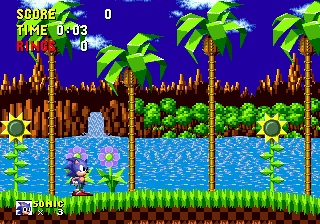 I can’t deny: Green Hill Zone does still call to me. Maybe some day someone will make a game worthy of those crisp screenshots that first appeared over twenty years ago. Until then, the particular anxiety that defines Sonic the Hedgehog remains. That persistent fear of being stopped. Interrupted. Out of the blue.
I can’t deny: Green Hill Zone does still call to me. Maybe some day someone will make a game worthy of those crisp screenshots that first appeared over twenty years ago. Until then, the particular anxiety that defines Sonic the Hedgehog remains. That persistent fear of being stopped. Interrupted. Out of the blue.
Published February 26th, 2011

This work is licensed under a Creative Commons Attribution-NonCommercial-ShareAlike 3.0 Unported License.